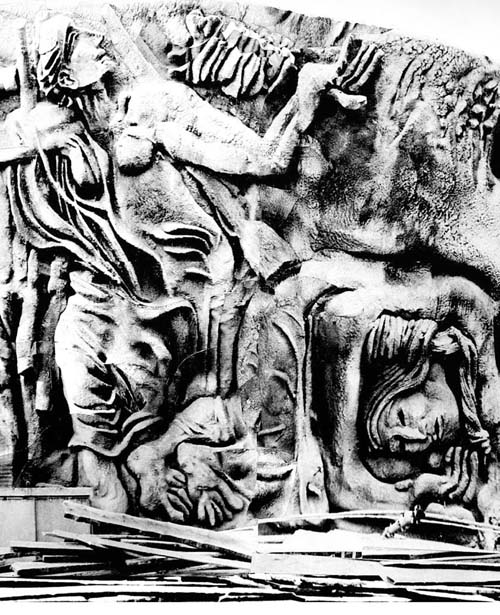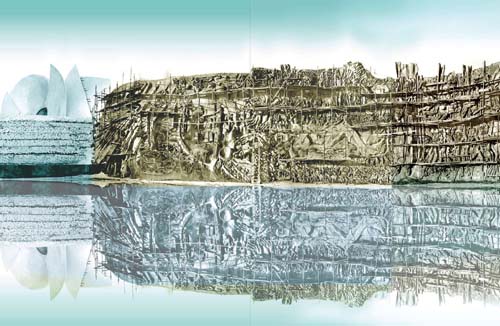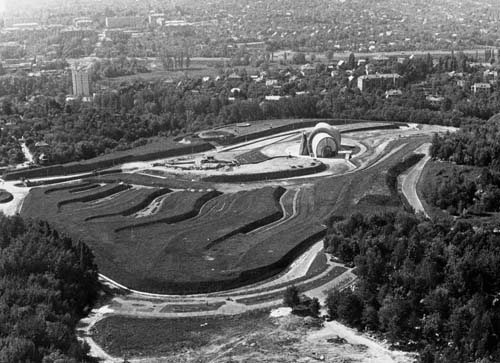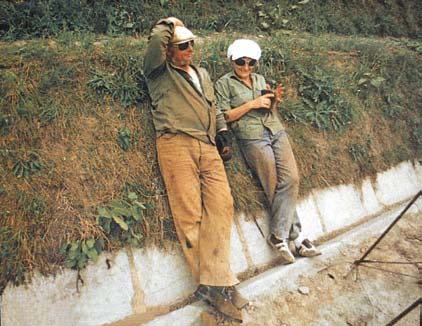The incident with the Park of Memory at the Baykove cemetery in 1982 is one of the biggest tragedies that has happened in Ukrainian culture. The names of Ada Rybachuk and Volodymyr Melnichenko are not inscribed in the history of Ukrainian art, although they devoted 13 years of their lives to the creation of a unique work of art – the architectural ensemble of the Park of Memory. When everything was almost ready for the official opening, the monumental bas-reliefs – a key element of the park – were barbarously destroyed.
Ada and Vladimir met at an art school, after graduating they studied together at an art institute, and after their first trip to the North in 1954, they never parted. Already at the institute, they were treated with caution, as they were considered nonconformists only because they dared to follow unknown paths, to take on everything new and unfamiliar, even if the implementation of the plan required the development of special technology. They defended their diplomas with a personal exhibition of paintings – for the first time in the history of the educational institution. Immediately after graduating from the institute, Ada painted a picture, which, unfortunately, was not allowed to the exhibition by the committee. The picture also received a prize abroad, which allowed her to travel all over Europe. In 1959, the media accused Ada and Vladimir of “boychukism” (a style in art of 1910-1930; artists who painted in this style were repressed, and all their works were destroyed). The children’s works were no longer accepted for participation in exhibitions, orders for illustrations of books were no longer received – in fact, they were isolated from working with institutions, leaving the opportunity to work only in the studio.
– For many years I have been asking myself the question: why Abraham Miletsky (known for such works as Park of Eternal Glory, crematorium on Baikove cemetery, Salyut Hotel, Landscape Alley) needed an order for the project of a crematorium, an object with that name and history? Why did he persuade us for eight whole months to take part in this work: from October 1967 to June 1968? Reminder: Will you participate? Then I’ll take the order. And without hesitation, after 13 years, he destroyed the architectural ensemble of the Memory Park – recalls Ada Rybachuk.
In 1968, Vladimir and Ada agreed to create, together with Abraham, a crematorium at the Baikove cemetery. They agreed to participate only on the condition that they would be involved in the work at all stages – from the concept to the plastic embodiment of the project in architecture.
– Miletsky’s first conversation with us took place in November 1967. At that time, he did not have sketches, not a single thought regarding the direction of designing the crematorium at the Baikove cemetery. The essence of the conversation – before agreeing to the order and starting the design, Miletsky had the goal of obtaining our consent to participate in this project. In March 1968 we had a discussion of the preliminary draft of Abraham. The project caused us a sharp rejection. We expressed our fundamental disagreement about an exclusively technological solution to the problem – in the complete absence of proposals for moral, aesthetic and spiritual aspects. Again, we decided categorically: we can take on the design only if we solve a complex of problems – not only solving a technological function, but starting the development of the project precisely from a philosophical concept, – to create an image of a memorial structure with architectural plasticity, – says Ada.
The artists set about developing the project knowing in advance that instead of building a factory for burning human bodies in a quick and convenient way, they would build a Memory Park: a monument not individual, but common – to all mankind. The project was approved and Ada Rybachuk and Vladimir Melnichenko set to work their whole life…
The Memory Park was designed as an architectural ensemble, the key elements of which were the farewell halls and a 200-meter-long wall with monumental bas-reliefs. The structure of the halls is a composition of seventeen concave shells facing the sky. In all the details that make up the complex, the authors tried to avoid static, expressing in the language of plasticity the continuous movement – the guarantee and condition for the existence of life. They sought to achieve lightness, but at the same time preserve monumentality, calling the object itself the Temple of Heaven.
Documentary about the Park of Remembrance (Wall of Remembrance)
The huge scale and placement of the bas-reliefs is not accidental – they were taken out into the street under the open sky in order for the image to be addressed to the next generations. The wall, 214 meters long, also performs an engineering function, strengthening the terraced cemetery. The reliefs saturated with stories captured the image of the era and the fate of all generations that built the state. Here was the self-sacrificing act of Prometheus, and the inspired rise of Icarus, and many other stories that do not hide the tragedy and drama of life, but at the same time call for communication, reflection, action instead of passive acceptance of death. The main parts of the Wall of Memory: Spring, Rainbow, Blooming Garden, Rain, Love, Creativity, Motherhood and others. Artificial pools were created at the base of the Wall of Remembrance. Thus, reflected in the water, the volume of the monument doubled, combined with the sky, the sun and the movement of clouds.
Out of 13 years of work on the project, 7 were devoted to the wall. Early one morning, in mid-January 1982, following an inexplicable intuition, they arrived at the site and saw a shocking picture: cars with people in uniform were arriving at the cemetery, and the wall was cordoned off. The fate of the bas-reliefs has already been decided – to be eliminated as soon as possible.
– The presence of the authors at all closed meetings was taken over by Miletsky on his own authority as the chief architect. He constantly and personally communicated with the secretaries of the city committee, misled them and lied that “Ada and Volodya let me down, they didn’t cope with the work, they abandoned the construction site, they didn’t manage to make wall reliefs, they only made a sketch in clay (by the way, this lie was discovered in 1989 year)”. I convinced everyone on behalf of the officials who allegedly gave the go-ahead for this, that the reliefs should at least be closed from the gaze of ordinary Soviet people, Ada says indignantly. – The most blasphemous thing about all this is that the central bus station, Palace of Pioneers and the crematorium are all our common projects, but everywhere Miletsky indicated only his own authorship, receiving, in addition to recognition, also awards – adds Rybachuk.
On March 21, 1982, at 8:00 am, 6 concrete mixers, at the direction of Miletsky, began the process of pouring concrete into the Wall of Memory, forever hiding the many years of work of two unrecognized artists. In total, more than 300 concrete mixers were needed to completely complete this act of barbarism. Other countries became interested in the fate of the Wall of Memory: Norway offered technical assistance, France and the United States volunteered to raise money for the reconstruction of the project. But letters and appeals to the leadership of the USSR remained unanswered – they did not like to admit mistakes there.
The documents on the basis of which the Wall of Memory was destroyed were canceled by one of the first decrees as soon as Ukraine gained independence. Moreover, there was a decision to restore the reliefs and recreate the Memory Park in full. Every year funds were allocated, but nothing was done. Instead, the crematorium continues to expand its territory, ordering new ovens and premises – a whole plant for burning human bodies has already been built there. The issue of restoring the Wall of Memory is no longer raised, and the city administration and the administration of the cemetery itself impede the progress of the case… In May 2018, 6 meters of the Wall of Memory were restored, the work was led by Vladimir Melnichenko, who plans to restore the entire bas-relief.
Where was the Memory Park (Memory Wall) located?
Baykova street, 16










